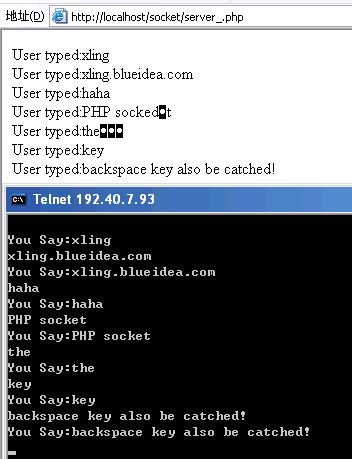PHP实现Socket服务器的代码_php技巧
ob_implicit_flush();
set_time_limit(0);
$address = "192.40.7.93";//换成你自己的地址
$port = 10000;
if(($socket = socket_create(AF_INET,SOCK_STREAM,SOL_TCP)) == false)
echo "错误(socket_create):".socket_strerror(socket_last_error())."
";
if(socket_bind($socket,$address,$port) == false)
echo "错误(socket_bind):".socket_strerror(socket_last_error())."
";
if(socket_listen($socket) == false)
echo "错误(socket_listen):".socket_strerror(socket_last_error())."
";
/*
After the socket socket has been created using socket_create() and bound to a name with socket_bind(),
it may be told to listen for incoming connections on socket.
*/
while(true){
if(($msgSocket = socket_accept($socket)) == false){
echo "错误(socket_accept):".socket_strerror(socket_last_error())."
";
break;
}
/*
this function will accept incoming connections on that socket.
Once a successful connection is made, a new socket resource is returned, which may be used for communication.
If there are multiple connections queued on the socket, the first will be used.
If there are no pending connections, socket_accept() will block until a connection becomes present.
If socket has been made non-blocking using socket_set_blocking() or socket_set_nonblock(), FALSE will be returned.
*/
$msg = "Welcome!
";
//socket_write($msg,$msg,strlen($msg));
$command = "";
while(true){
if(($buf = socket_read($msgSocket,2048,PHP_BINARY_READ)) == false){
echo "错误(socket_read):".socket_strerror(socket_last_error())."
";
break 2;
}
/*
The function socket_read() reads from the socket resource socket created by the socket_create() or socket_accept() functions.
The maximum number of bytes read is specified by the length parameter.
Otherwise you can use \r, \n, or \0 to end reading (depending on the type parameter, see below).
*/
/*
if(!$buf = trim($buf))
continue; // ????
if($buf == "quit")
break;
if($buf == "shutdown"){
socket_close($msgSocket);
break 2;
}
$tallBack = "You say:$buf\n";
socket_write($msgSocket,$tallBack,strlen($tallBack));
*/
if(ord($buf) != 13)
$command .= $buf;
else{
$command1 = "You Say:$command\r\n";
socket_write($msgSocket,$command1,strlen($command1));
echo "User typed:".$command."
";
$command = "";
}
}
socket_close($msgSocket);
}
socket_close($socket);
?>
然后打开CMD,输入:telnet 192.40.7.93 10000,自己体验去吧! 
注,要把:php_sockets.dll 打开

Heiße KI -Werkzeuge

Undresser.AI Undress
KI-gestützte App zum Erstellen realistischer Aktfotos

AI Clothes Remover
Online-KI-Tool zum Entfernen von Kleidung aus Fotos.

Undress AI Tool
Ausziehbilder kostenlos

Clothoff.io
KI-Kleiderentferner

AI Hentai Generator
Erstellen Sie kostenlos Ai Hentai.

Heißer Artikel

Heiße Werkzeuge

Notepad++7.3.1
Einfach zu bedienender und kostenloser Code-Editor

SublimeText3 chinesische Version
Chinesische Version, sehr einfach zu bedienen

Senden Sie Studio 13.0.1
Leistungsstarke integrierte PHP-Entwicklungsumgebung

Dreamweaver CS6
Visuelle Webentwicklungstools

SublimeText3 Mac-Version
Codebearbeitungssoftware auf Gottesniveau (SublimeText3)

Heiße Themen
 CakePHP-Projektkonfiguration
Sep 10, 2024 pm 05:25 PM
CakePHP-Projektkonfiguration
Sep 10, 2024 pm 05:25 PM
In diesem Kapitel werden wir die Umgebungsvariablen, die allgemeine Konfiguration, die Datenbankkonfiguration und die E-Mail-Konfiguration in CakePHP verstehen.
 PHP 8.4 Installations- und Upgrade-Anleitung für Ubuntu und Debian
Dec 24, 2024 pm 04:42 PM
PHP 8.4 Installations- und Upgrade-Anleitung für Ubuntu und Debian
Dec 24, 2024 pm 04:42 PM
PHP 8.4 bringt mehrere neue Funktionen, Sicherheitsverbesserungen und Leistungsverbesserungen mit einer beträchtlichen Menge an veralteten und entfernten Funktionen. In dieser Anleitung wird erklärt, wie Sie PHP 8.4 installieren oder auf PHP 8.4 auf Ubuntu, Debian oder deren Derivaten aktualisieren. Obwohl es möglich ist, PHP aus dem Quellcode zu kompilieren, ist die Installation aus einem APT-Repository wie unten erläutert oft schneller und sicherer, da diese Repositorys in Zukunft die neuesten Fehlerbehebungen und Sicherheitsupdates bereitstellen.
 CakePHP Datum und Uhrzeit
Sep 10, 2024 pm 05:27 PM
CakePHP Datum und Uhrzeit
Sep 10, 2024 pm 05:27 PM
Um in cakephp4 mit Datum und Uhrzeit zu arbeiten, verwenden wir die verfügbare FrozenTime-Klasse.
 CakePHP-Datei hochladen
Sep 10, 2024 pm 05:27 PM
CakePHP-Datei hochladen
Sep 10, 2024 pm 05:27 PM
Um am Datei-Upload zu arbeiten, verwenden wir den Formular-Helfer. Hier ist ein Beispiel für den Datei-Upload.
 Besprechen Sie CakePHP
Sep 10, 2024 pm 05:28 PM
Besprechen Sie CakePHP
Sep 10, 2024 pm 05:28 PM
CakePHP ist ein Open-Source-Framework für PHP. Es soll die Entwicklung, Bereitstellung und Wartung von Anwendungen erheblich vereinfachen. CakePHP basiert auf einer MVC-ähnlichen Architektur, die sowohl leistungsstark als auch leicht zu verstehen ist. Modelle, Ansichten und Controller gu
 CakePHP-Routing
Sep 10, 2024 pm 05:25 PM
CakePHP-Routing
Sep 10, 2024 pm 05:25 PM
In diesem Kapitel lernen wir die folgenden Themen im Zusammenhang mit dem Routing kennen.
 CakePHP arbeitet mit Datenbank
Sep 10, 2024 pm 05:25 PM
CakePHP arbeitet mit Datenbank
Sep 10, 2024 pm 05:25 PM
Das Arbeiten mit der Datenbank in CakePHP ist sehr einfach. In diesem Kapitel werden wir die CRUD-Operationen (Erstellen, Lesen, Aktualisieren, Löschen) verstehen.
 CakePHP erstellt Validatoren
Sep 10, 2024 pm 05:26 PM
CakePHP erstellt Validatoren
Sep 10, 2024 pm 05:26 PM
Der Validator kann durch Hinzufügen der folgenden zwei Zeilen im Controller erstellt werden.






